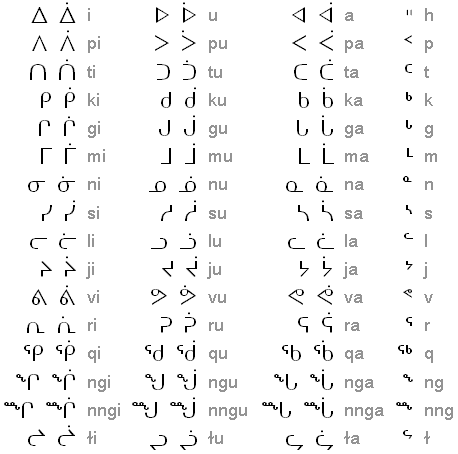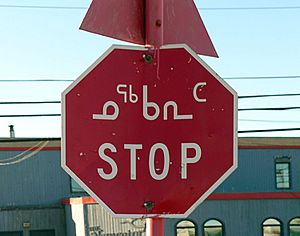Inuktitut syllabics facts for kids
Quick facts for kids Inuktitut syllabics |
|
|---|---|

Inuktitut syllabary. Extra characters with dots represent long vowels; When romanized, the vowel is duplicated.
|
|
| Type | Abugida |
| Spoken languages | Inuktitut |
| Time period | 1870s–present |
| Parent systems |
Cree syllabics
|
| Unicode range | Unified Canadian Aboriginal Syllabics, U+1400–167F (chart) |
| ISO 15924 | Cans |
| Note: This page may contain IPA phonetic symbols in Unicode. | |

Inuktitut syllabics (Inuktitut: ᖃᓂᐅᔮᖅᐸᐃᑦ, or ᑎᑎᕋᐅᓯᖅ ᓄᑖᖅ, titirausiq nutaaq) is a special way of writing used by the Inuit people in Canada. It's used in places like Nunavut, Nunavik (in Quebec), and Nunatsiavut (in Labrador).
This writing system is called an abugida. This means that each main symbol stands for a consonant sound followed by a vowel sound. For example, one symbol might mean "pa," and another might mean "pi."
In 1976, the Inuit Cultural Institute decided that Inuktitut syllabics would be one of the official ways to write the Inuit languages. The other official way is using the Latin alphabet, which is the alphabet English uses.
The name qaniujaaqpait comes from the word qaniq, which means "mouth." Another name, Titirausiq nutaaq, means "new writing system." This name helps tell it apart from the "old syllabics" that were used before the changes in 1976.
History of Inuktitut Syllabics
The first attempts to write the Inuktitut language happened in the mid-1800s. Missionaries from the Moravian Church in Greenland and Labrador started writing Inuktitut using the Latin alphabet.
Later, in 1855–56, a book was printed in Inuktitut using a writing system similar to Cree syllabics. This book was called Selections from the Gospels in the dialect of the Inuit of Little Whale River. It was printed by John Horden for use among the Inuit.
In the 1870s, another missionary named Edmund Peck began printing Inuktitut using this adapted system. Over time, other missionaries and language experts working for the Canadian and American governments also helped adapt the Latin alphabet for different Inuktitut dialects in the western Arctic regions.
Inuktitut syllabics is part of a larger group of writing systems called Canadian Aboriginal syllabics. Today, you can find Inuktitut characters on computers and other digital devices because they are part of the Unicode standard, which helps computers understand text from different languages.
In the Inuktitut writing system, a syllable can start with a consonant like g, j, k, l, m, n, p, q, r, s, t, v, ng, or ł. Sometimes, there's no consonant at the beginning. The vowel sound that follows can be a, i, u, or ai. Sometimes, there's no vowel sound at all.
How the Syllabics Work
The Inuktitut script (titirausiq nutaaq) is often shown as a table of syllables. Each symbol in the table represents a syllable.
- If a symbol has a dot on it, it means the vowel sound is long. For example, if a symbol means "pi," the one with a dot might mean "pii."
- When Inuktitut is written using the Latin alphabet, a long vowel is shown by doubling the vowel letter (like "aa" or "ii").
- When two consonants are the same and appear together (like "kk" or "nn"), a special symbol for the final consonant is placed before the next syllable. For example, -kku- is written as ᒃᑯ.
Here are the tables that show the different Inuktitut syllabic characters:
| Short | Trans. |
|---|---|
| ᐁ | ai |
| ᐯ | pai |
| ᑌ | tai |
| ᑫ | kai |
| ᕴ | hai |
| ᒉ | gai |
| ᒣ | mai |
| ᓀ | nai |
| ᓭ | sai |
| ᓓ | lai |
| ᔦ | jai |
| ᑦᔦ | jjai |
| ᕓ | vai |
| ᕂ | rai |
| ᙯ | qai |
| ᖅᑫ | qqai |
| ᙰ | ŋai |
| Short | Long | Trans. |
|---|---|---|
| ᐃ | ᐄ | i |
| ᐱ | ᐲ | pi |
| ᑎ | ᑏ | ti |
| ᑭ | ᑮ | ki |
| ᕵ | ᕶ | hi |
| ᒋ | ᒌ | gi |
| ᒥ | ᒦ | mi |
| ᓂ | ᓃ | ni |
| ᓯ | ᓰ | si/hi |
| 𑪶 | 𑪷 | ši |
| 𑪰 | 𑪱 | hi |
| ᓕ | ᓖ | li |
| ᔨ | ᔩ | ji |
| ᑦᔨ | ᑦᔩ | jji |
| ᖨ | ᖩ | ři |
| ᕕ | ᕖ | vi |
| ᕆ | ᕇ | ri |
| ᕿ | ᖀ | qi |
| ᖅᑭ | ᖅᑮ | qqi |
| ᖏ | ᖐ | ŋi |
| ᙱ | ᙲ | ŋŋi |
| ᖠ | ᖡ | łi |
| Short | Long | Trans. |
|---|---|---|
| ᐅ | ᐆ | u |
| ᐳ | ᐴ | pu |
| ᑐ | ᑑ | tu |
| ᑯ | ᑰ | ku |
| ᕷ | ᕸ | hu |
| ᒍ | ᒎ | gu |
| ᒧ | ᒨ | mu |
| ᓄ | ᓅ | nu |
| ᓱ | ᓲ | su/hu |
| 𑪸 | 𑪹 | šu |
| 𑪲 | 𑪳 | hu |
| ᓗ | ᓘ | lu |
| ᔪ | ᔫ | ju |
| ᑦᔪ | ᑦᔫ | jju |
| ᖪ | ᖫ | řu |
| ᕗ | ᕘ | vu |
| ᕈ | ᕉ | ru |
| ᖁ | ᖂ | qu |
| ᖅᑯ | ᖅᑰ | qqu |
| ᖑ | ᖒ | ŋu |
| ᙳ | ᙴ | ŋŋu |
| ᖢ | ᖣ | łu |
| Short | Long | Trans. |
|---|---|---|
| ᐊ | ᐋ | a |
| ᐸ | ᐹ | pa |
| ᑕ | ᑖ | ta |
| ᑲ | ᑳ | ka |
| ᕹ | ᕺ | ha |
| ᒐ | ᒑ | ga |
| ᒪ | ᒫ | ma |
| ᓇ | ᓈ | na |
| ᓴ | ᓵ | sa/ha |
| 𑪺 | 𑪻 | ša |
| 𑪴 | 𑪵 | ha |
| ᓚ | ᓛ | la |
| ᔭ | ᔮ | ja |
| ᑦᔭ | ᑦᔮ | jja |
| ᖬ | ᖭ | řa |
| ᕙ | ᕚ | va |
| ᕋ | ᕌ | ra |
| ᖃ | ᖄ | qa |
| ᖅᑲ | ᖅᑳ | qqa |
| ᖓ | ᖔ | ŋa |
| ᙵ | ᙶ | ŋŋa |
| ᖤ | ᖥ | ła |
| Final | Trans. |
|---|---|
| ᑉ | p |
| ᑦ | t |
| ᒃ | k |
| ᕻ | h |
| ᒡ | g |
| ᒻ | m |
| ᓐ | n |
| ᔅ | s/h |
| š | |
| h | |
| ᓪ | l |
| ᔾ | j |
| ᑦᔾ | jj |
| ᖮ | ř |
| ᕝ | v |
| ᕐ | r |
| ᖅ | q |
| ᖅᒃ | |
| ᖕ | ŋ |
| ᖖ | ŋŋ |
| ᖦ | ł |
| ᖯ | b |
| ᕼ | h |
| ᑊ | ʼ |
Changes to the Script
Over time, the Inuktitut script has seen some changes. For example, the Makivik Corporation helped bring back a special column of symbols called the ai-pai-tai column.
This column is for the "ai" vowel sound. Before, the "ai" sound was often written by combining the "a" symbol with a separate "i" symbol. The "ai-pai-tai" column was removed in the 1970s because of limits with old typewriters. But now, with modern computers and printers, these limits are gone, so the "ai-pai-tai" column is used again, mainly in the Nunavik region.
See also
 In Spanish: Silabario inuktitut para niños
In Spanish: Silabario inuktitut para niños

